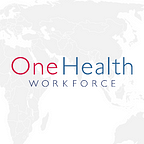10 Things to Know About One Health Workforce’s Monitoring & Evaluation Program
A Look at Our Project
1.The One Health Workforce Monitoring & Evaluation (M&E) team includes four specialists in the United States and Europe who work together with M&E liaisons in the One Health Central and East Africa Network (OHCEA) and the Southeast Asia One Health University Network (SEAOHUN).
2. The goal of the One Health Workforce (OHW) project is to improve the capacity of the health workforce in the 12+ countries where we work to better prevent, detect, and respond to infectious and zoonotic disease threats.
3. Our Theory of Change is a framework that shows how our different strategies and activities will help us achieve our mission. Our project focuses on three complementary strategies of professional development, institutional strengthening, and multi-sectoral engagement.
4. We monitor activities against our 5 project objectives: 1) Workforce Engagement, 2) Pre-Service Training, 3) In-Service Training, 4) Faculty Development, and 5) Organizational Development.
5. We also measure the impact of our activities on individuals and institutions within the health workforces to ensure the project is fulfilling its mission.
6. Tracking progress across multiple continents and countries isn’t easy, so we focus on specific outputs and outcomes. Outputs look at things like the products we develop (e.g. educational materials) and the people we train. Outcomes focus on how those outputs are put into use and with what results. For example, we look to see if health professionals are using the skills and competencies they gained from our trainings in their work.
7. Why do we do M&E? Part of the job of M&E is to show accountability to our funder, USAID, and members. We also do M&E to inform others about our work (with help from our Communications team) and demonstrate our project’s value.
8. We also support organizational learning across our network. As universities and networks gain experience implementing activities, it’s important to understand what was effective so that future implementation can be improved.
9. We can’t do it alone! In the past year, we’ve trained faculty partners on the basics of designing and implementing an evaluation. Through these workshops, faculty designed evaluation plans for different project activities.
10. We’re always looking for new and exciting projects to measure the work on our project. One thing we’re currently working on is a Social Network Analysis to measure connections and relationships between our networks and external partners, as well as working with data visualization programs such as Tableau, which can create simple dashboards to help us monitor our progress in real time.
About the Author
Ian Allen is an M&E Specialist on the USAID One Health Workforce project.
